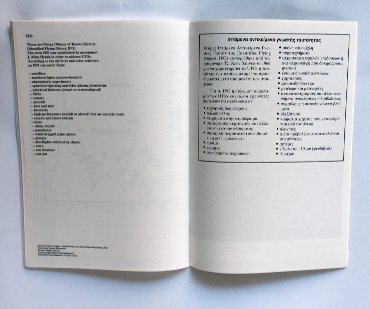Definitions of the Undefined
Encyclopaedia, 2013
Individuals from all over the world photographed and/or copied definitions from representative reference books. The specific contributions are arranged in alphabetic order by the country of origin and includes the cover and translation. The individual contributions are published in a magazine - an edition of 130 pieces - featuring the definitions and a picture section.

|

|

|

|
Preface:
Encyclopaedias are a great knowledge store, a consolidation of human knowledge spanning any given subject.
The content is considered scientific and reliable and is usually consulted to obtain a precise definition of a term.
The terminology Unidentified Flying Object (UFO) is generally universally accepted as shown by diverse co-entries in various
encyclopaedias from around the world. For the most part, these definitions are based on technological ingenuities.
My interest in UFOs is borne out of a consideration for them not only as objects and technological appliances but also as figures
of thought - realities and fictions emerging from thoughts meditating towards the limits of these technological constructs.
This imaginary surplus becomes apparent in the process of the intention and function of the (technological) construct by needs,
desire and expectations1.
Above all, my main question is how abstract terminologies, such as an unknown and undefined object, is ultimately defined and objectified
and can lead to such a universally understood concept. My lead question therefore is, do the various entries show any congruities and if so,
in what ways do they differentiate?
Furthermore I am interested in whether any reference to Tekhné2 is made, which in Ancient Greek characterized the possibilities
of exorbitance and excess par excellence. Also, by interacting with the imaginary surplus does the term expand towards an artistic context?
Translated from Bernhard Stiegler: Denken bis an die Grenze der Maschine, Zürich/Berlin, 2009
K. G. Pontus Hultén: The machine : as seen at the end of the mechanical age, New York, NY : The Museum of Modern Art, 1968

[Data]
Picture of the edition "Encyclopedia - Definitions of the undefined" (zip|9.8MB)
[Present at]
'Das Abenteuer Bildung' - exhibition at Charles Vöegele Kulturzentrum from 17.11.2013 – 23.03.2014, Pfäffikon, CH.
'Hagulane' - Group exhibition, 29.June-31.August 2014, municipal gallery Villingen-Schwenningen, BRD.
[Technology]
Silkscreen, Riso-print, BW-print
Thanks to: Cristiano Alessandro, Kristian de Borysevicz, Cyrille Henry, Timo Hoffmann, Fiona Inglis, Naveen Kuppuswamy, Vlada Maria, Belencia Martinez, Varvara Mitropolous, Anna Kari Sandvik, David Skirnisson, Riika Tauriainen, Simo Tauriainen, Madga Tzakosta, Gisela Usenko, Hung Q. Vu, Marc Winter, Nathalie Kilias.
